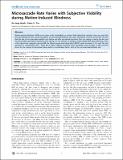Microsaccade rate varies with subjective visibility during motion-i= blindness
Author(s)
Hsieh, Po-Jang; Tse, Peter U.
DownloadHsieh-2009-Microsaccade rate va.pdf (779.6Kb)
PUBLISHER_CC
Publisher with Creative Commons License
Creative Commons Attribution
Terms of use
Metadata
Show full item recordAbstract
Motion-induced blindness (MIB) occurs when a dot embedded in a motion field subjectively vanishes. Here we report the first psychophysical data concerning effects of microsaccade/eyeblink rate upon perceptual switches during MIB. We find that the rate of microsaccades/eyeblink rises before and after perceptual transitions from not seeing to seeing the dot, and decreases before perceptual transitions from seeing it to not seeing it. In addition, event-related fMRI data reveal that, when a dot subjectively reappears during MIB, the blood oxygen-level dependent (BOLD) signal increases in V1v and V2v and decreases in contralateral hMT+. These BOLD signal changes observed upon perceptual state changes in MIB could be driven by the change of perceptual states and/or a confounding factor, such as the microsaccade/eyeblink rate.
Date issued
2009-04Department
McGovern Institute for Brain Research at MITJournal
PLoS ONE
Publisher
Public Library of Science
Citation
Hsieh P-J, Tse PU (2009) Microsaccade Rate Varies with Subjective Visibility during Motion-Induced Blindness. PLoS ONE 4(4): e5163. doi:10.1371/journal.pone.0005163
Version: Final published version
ISSN
1932-6203